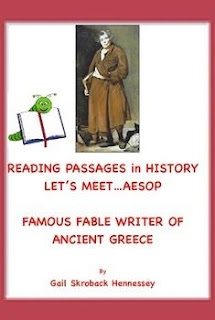WHY STUDY HISTORY?
“Why do we have to learn this stuff” is a common question my students would ask me while learning about Julius Caesar and the fall of the Roman republic or other topics in social studies. Of course, I would explain that the the past is important to learn because past events are the building blocks that create our present.
With a new year beginning, it's a great way to start a discussion on just WHY study history and encourage responses from students.
I like to remind students of when they were little and played the game of "Telephone". Remember, sitting in a circle and someone would whisper something in your ear and you would pass along the information to the person sitting next to you? History of the world is kind of like that game. People through the ages have passed down ideas which are still used today.
EVERYTHING has a history, from the potato chip we eat, to the tissues we use to blow our noses, to the shoes we are wearing, to the pencil we use to jot down a note. Everything was once an idea that someone developed, passed along and in some ways was improved upon by those that learned of the idea.
We are very connected to the past as it has shaped the present that we have today!
EVERYTHING has a history, from the potato chip we eat, to the tissues we use to blow our noses, to the shoes we are wearing, to the pencil we use to jot down a note. Everything was once an idea that someone developed, passed along and in some ways was improved upon by those that learned of the idea.
We are very connected to the past as it has shaped the present that we have today!
Here are some examples of "World-History Telephone"
1. You get up and look at the clock and see that it’s time to get ready for school. Did you know that the ancient people of Mesopotamia (people that lived in the present day country of Iraq) had a counting system based on 60? That’s how high they could count on their joints on their fingers and toes, and that’s the bases of our time counting today!
2. You look at the calendar and see that it’s Thursday. Thank the people of Mesopotamia again. They established a seven day week. Seems they had seven main gods that they wished to honor each day.
3. Even the names of some of the days of the week came from people living many years ago. The Vikings had several main gods which they worshiped on a certain day. “Tiew’s day” became Tuesday, “Woden’s Day” became Wednesday and “Thor’s Day” became Thursday.
4. Staying with the calendar, did you ever wonder why there are 365 day in a year? Yes, that’s another gift from the past. The ancient Egyptians had 360 days in their calendar and added 5 extra days at the end of the year for a BIG harvest party.
5. The earliest bathroom was excavated in a place called Orkney Islands, Scotland. The bathroom excavated dated back to 8000 BCE.
6. You grab onto a bar of soap. Soap was invented about 600 BCE, by the ancient Phoenicians (of present day Lebanon). They made their soap from goat fat and wood ash.
7.Pick up a fork and thank someone from the country of Italy who lived in the 11th century. Before this time, people ate with their fingers. In fact, for many years it was considered poor manners to use that metal contraption called a fork.
I have a reading which I have developed sharing many things in our world that came from us from other past cultures. It includes comprehension questions and a couple of extension activities. It would be a great beginning of the school year activity to show kids that "history is all around us".
Click here to see a preview and to purchase: https://www.teacherspayteachers.com/Product/Why-Study-History-Reading-in-Social-Studies-Our-Past-Shapes-our-Present-3164074
Note: The illustration is from Phoencia.org and wpclipart.com













